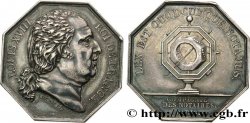正面
正面的文字 CHARLES X - ROI DE FRANCE.
正面的说明书 Buste de Charles X à droite, signé N. TIOLIER.
背面
背面的文字 NOTAIRES ROYAUX DE L’ARROND. DE LA REOLE - GIRONDE.
背面的说明书 Dans une couronne de deux branches de chêne liées par un noeud de ruban une fleur de lis au-dessus du noeud et une autre au-dessus de l’endroit où les branches de chêne se rejoignent. A l’intérieur et en trois lignes : LEX EST / QUODCUMQUE / NOTAMUS..
背面的翻译 Le lion impose sa loi aux animaux, nos écrits l'imposent aux hommes.
评论
历史细节
19TH CENTURY NOTARIES (SOLICITORS AND ATTORNEYS)
The Le Chapelier law of June 17, 1791, which dissolves the corporations, therefore the companies of notaries, then the law of October 6, 1791 suppresses the royal, apostolic and seigneurial notaries as well as the venality and the inheritance of their offices. However, the authors of this second law, recognizing the need for the authentication of deeds and the duty to advise, institute public notaries. Thus notaries remain in practice by changing quality. However, after a decade of legislative trial and error, the First Consul Bonaparte reorganized and modernized the notariat by the organic law of 25 Ventôse of the year XI (March 16, 1803). This veritable "notarial code" remains today the reference text of the profession.. The 19th century notary is an emblematic figure that can be found in literature but also in opera. One of the most famous figures is in the third act of Puccini's opera, "Il Trittico", performed for the first time in 1918, and whose action takes place in the 19th century.. The most famous aria is that of Gianni Schicchi: “Si corre dal notaio!” (“Let’s go to the notary!”) [http://www. Youtube. com/watch?v=0OjuOxOCFVI].










 对产品描述纠错
对产品描述纠错 打印
打印 分享我的选择
分享我的选择 提问
提问 Consign / sell
Consign / sell
 产品介绍
产品介绍









